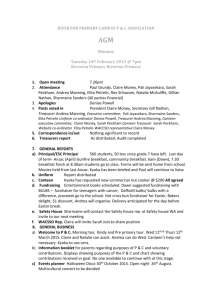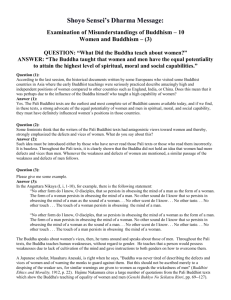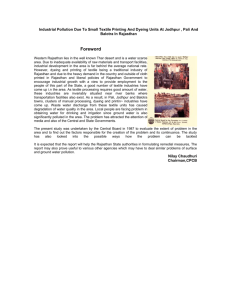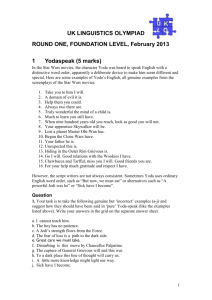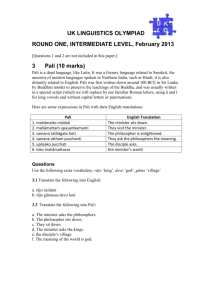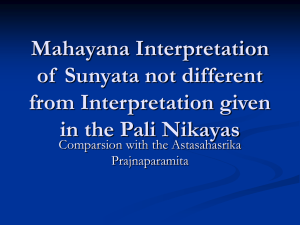USING THE PALI TEXTS
advertisement
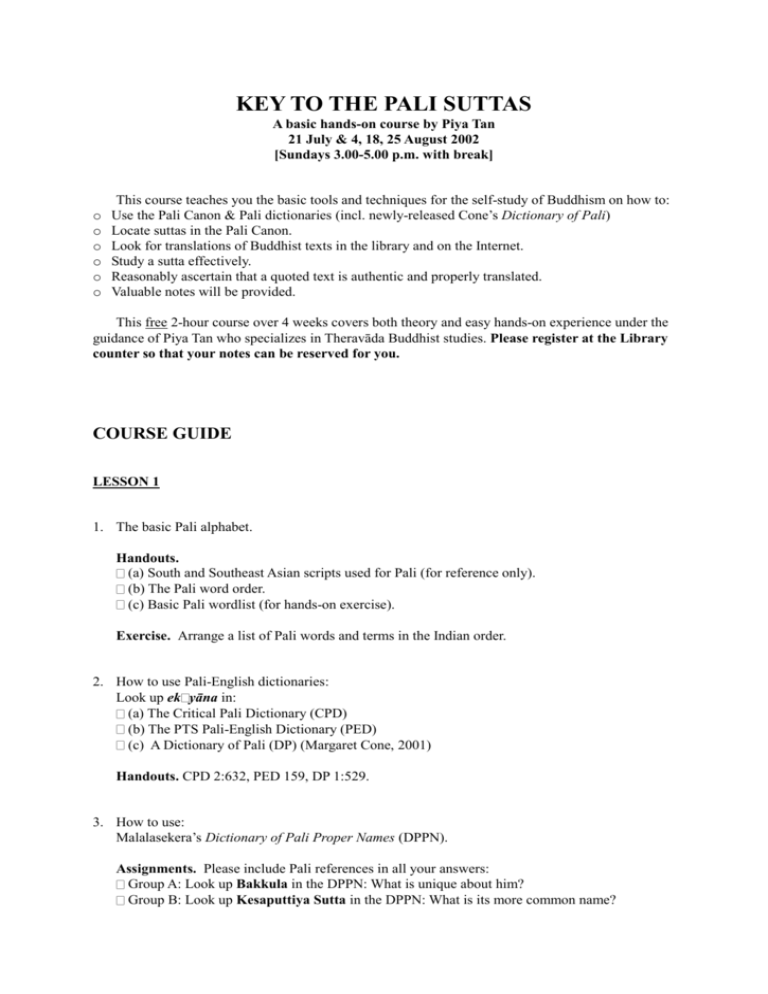
KEY TO THE PALI SUTTAS A basic hands-on course by Piya Tan 21 July & 4, 18, 25 August 2002 [Sundays 3.00-5.00 p.m. with break] o o o o o o This course teaches you the basic tools and techniques for the self-study of Buddhism on how to: Use the Pali Canon & Pali dictionaries (incl. newly-released Cone’s Dictionary of Pali) Locate suttas in the Pali Canon. Look for translations of Buddhist texts in the library and on the Internet. Study a sutta effectively. Reasonably ascertain that a quoted text is authentic and properly translated. Valuable notes will be provided. This free 2-hour course over 4 weeks covers both theory and easy hands-on experience under the guidance of Piya Tan who specializes in Theravāda Buddhist studies. Please register at the Library counter so that your notes can be reserved for you. COURSE GUIDE LESSON 1 1. The basic Pali alphabet. Handouts. (a) South and Southeast Asian scripts used for Pali (for reference only). (b) The Pali word order. (c) Basic Pali wordlist (for hands-on exercise). Exercise. Arrange a list of Pali words and terms in the Indian order. 2. How to use Pali-English dictionaries: Look up ek yāna in: (a) The Critical Pali Dictionary (CPD) (b) The PTS Pali-English Dictionary (PED) (c) A Dictionary of Pali (DP) (Margaret Cone, 2001) Handouts. CPD 2:632, PED 159, DP 1:529. 3. How to use: Malalasekera’s Dictionary of Pali Proper Names (DPPN). Assignments. Please include Pali references in all your answers: Group A: Look up Bakkula in the DPPN: What is unique about him? Group B: Look up Kesaputtiya Sutta in the DPPN: What is its more common name? Using the Pali Texts: Study Guide (Piya Tan, 2002) LESSON 2 3a. Feedback on assignments. Please include Pali references in all your answers: Group A: Look up Bakkula in the DPPN: What is unique about him? Group B: Look up Kesaputtiya Sutta in the DPPN: What is its more common name? 4. The Pali Canon and Extra-canonical works: a brief survey. Handout 4. The Pali Canon and Extra-canonical works. (Piyasilo 1990f:106-114) 5. Text and Commentary: a brief introduction. Handouts. (a) The Pali Canon: editions (Piyasilo 1990f:105) (b) The Pali Commentaries (Piyasilo 1990f:115) 6. Editions and translations: what is the difference? D gha Nikāya, Majjhima Nik ya, Sa yutta Nik ya, A guttara Nik ya, Khuddaka Nik ya (Piyasilo 1990f:108-113) Handouts. (a) D gha Nik ya (PTS Pali edition) D 2:290. (b) The Long Discourses of the Buddha (translation by M. Walshe), D:W 1995:335. Hands-on. Abbreviations used for: (c) Texts. (d) Translations. Assignment. Locate Dhammapada verses 273-276 (Pali text & English translation). LESSON 3 6e. Feedback on Assignment. Locate Dhammapada verses 273-276 (Pali text & English translation). 7. How to locate a Pali text (translation): Handout 4: (a) Volume & page. (b) Sutta number, etc. 8. How to use the Pali Tipi aka Concordance (PTC). Handout. Sample page (pā tip ta). 9. How to use a reverse index. Handout. A P da Index and Reverse P da Index to Early P li Canonical Texts.Yamazaki & Ousaka, Tokyo: Kosei, 2000. (ye keci p abh t’atthi…) 2 Using the Pali Texts: Study Guide (Piya Tan, 2002) 10. Critical Pali Dictionary (CPD) reference system & textual hierarchy: a brief survey. Handout. Summary list of titles headings from CPD Epilegomena: updated version in Oskar von Hinuber’s A Handbook of P li Literature (1996). 11. Sources and resources: (a) Websites on Pali and Buddhist studies Online Pali Canons: the Sri Lanka Tipi aka Project (SLTP) Free online dictionaries: Pali-English Dictionaries, etc. (b) Journals on Pali and Buddhist studies Articles on Buddhism: Free and good online journals, such as Journal of Buddhist Ethics. (c) Pali fonts. What they are and where to find them. 11d. ASSIGNMENT [13] Suggested Pre-reading for Sig l’ov da Sutta: T.W. Rhys Davids’s introduction essay (D:R 3:168-172). LESSON 4 12. Contents and purpose of the Nik yas: a new discovery? (Summary) [Optional reading: Joy Manné, “Categories of Sutta in the P li Nik yas and Their Implications for our Appreciation of the Buddhist Teaching and Literature.” Journal of the Pali Text Society 15 1990:29-87.] 13. Sutra Appreciation. Handouts (a) John Bullitt, “Befriending the Suttas: Some suggestions for reading for Pali Discourses” (2002) (www.accesstoinsight.org/sutta101.htm). (b) “Preparing a Close Reading of the Buddhist Sutras.” (Harvard University) Suggested Pre-reading: T.W. Rhys Davids’s introduction essay (D:R 3:168-172). Study text: Sig l’ov da Sutta (D no. 31): Handouts (c) Phra Prayudh Payutto’s translation (The Buddha’s Discourses for Beginners, 2nd ed 1969) (d) Maurice Walshe’s translation (The Long Discourses of the Buddha, 1996). [020628] 3
![(B) A Case of Pali (1/2) [10 points]](http://s3.studylib.net/store/data/008167053_1-c61803c70b2657605164745567d0cb3a-300x300.png)

